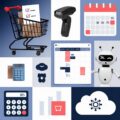The retail industry is currently undergoing a significant transformation as brands strive to find new and innovative ways to engage customers across multiple channels. This has led to the emergence of headless platforms in retail, a cutting-edge approach that separates the front end from the back end. This allows retailers to create custom, highly responsive shopping experiences that can seamlessly adapt to different touchpoints. Unlike traditional systems where the front and back end are tightly connected, headless platforms decouple them, providing flexibility that empowers retailers to quickly adapt to changing market demands and customer preferences.
In today’s digital era, staying competitive requires constant evolution. This is where headless commerce development comes into play. It offers a framework that supports rapid experimentation and feature enhancements without disrupting the core architecture. By leveraging headless technology, retailers are no longer constrained by rigid systems; instead, they can respond to trends, test new ideas, and offer enhanced shopping experiences that keep customers coming back.
Why Retailers Are Adopting Headless Commerce
There are several compelling reasons why the retail industry is increasingly leaning toward headless platforms:
- Flexibility: Headless platforms allow retailers to customize their front end independently, enabling them to create unique and engaging interfaces.
– Speed: Changes can be made quickly on the front end without overhauling the entire system. This is crucial for staying relevant in a fast-paced digital environment.
– Omnichannel Capability: Headless platforms support seamless integration across various channels such as websites, mobile apps, voice assistants or even IoT devices.
- Improved Developer Experience: By decoupling the front and back end, developers can work on each aspect independently which streamlines processes and enhances productivity.
These benefits collectively position headless commerce as a powerful tool for retailers aiming to innovate and offer an outstanding user experience.
Key Features of Headless Platforms
When evaluating headless platforms for retail use cases several core features stand out which distinguish them from traditional, monolithic systems:
– API-First Approach: This allows for seamless integration with various applications, services, and platforms.
– Front-End Agnosticism: Retailers can use any front-end technology they prefer, whether it’s React, Vue.js, or even emerging frameworks.
– Customizable User Experiences: The flexibility to craft unique interfaces for each device, channel, or audience segment.
– Scalability: This enables retailers to scale components individually offering more control and lower costs.
– Real-Time Data Access: Provides faster and more responsive user interactions which is especially important for personalized customer experiences.
Each of these features contributes to a robust framework that allows retailers to evolve quickly and cater to changing consumer demands without the limitations of a traditional system.
How Headless Commerce Enhances Retail Innovation
Headless platforms drive the latest retail innovations by allowing brands to experiment with new ideas and adapt quickly to market changes. Here’s how they foster innovation:
– Rapid Experimentation: Retailers can test new features, layouts, and functionalities on the front end without disrupting back-end operations. This ability empowers brands to stay on the cutting edge.
– Seamless Omnichannel Integration: A headless architecture enables retailers to connect with customers through multiple channels such as web, mobile, social media or in-store kiosks – all with a unified experience. This helps create a seamless and cohesive journey that meets customers wherever they are.
– Enhanced Personalization: By decoupling the front end from the back end, brands can implement more dynamic and personalized shopping experiences tailored to customer preferences such as browsing history or location. APIs and data-driven insights enable
Retailers embracing headless commerce development have the opportunity to push boundaries and redefine how they interact with customers, creating memorable shopping experiences that foster brand loyalty and customer engagement.
Competitive Advantages of Headless Platforms in Retail
The adoption of headless platforms in retail brings distinct competitive advantages that can set brands apart in a crowded marketplace:
- Speed to Market: Retailers using headless platforms can launch new features and updates much faster than those relying on traditional monolithic systems. This speed is crucial in a competitive landscape where customers’ expectations are constantly evolving.
- Enhanced Customer Experience: With the ability to deliver tailored, device-specific experiences, headless platforms empower retailers to meet customers’ needs more effectively. Whether it’s a highly interactive mobile app or an easy-to-navigate website, headless platforms allow brands to adapt their interfaces for the best possible experience.
- Cost Efficiency Over Time: While initial setup costs for a headless platform can be higher, the long-term savings from quicker updates and reduced need for costly redesigns can be substantial. This approach is particularly beneficial for retailers seeking an agile, cost-effective solution.
- Future-Proofing: As technology continues to evolve, a headless approach ensures that retailers can integrate new tools and channels without overhauling their entire system. This adaptability makes it easier for brands to stay relevant and leverage new technologies as they emerge.
The competitive edge provided by headless platforms gives retailers the agility to navigate industry changes, helping them stay ahead of trends and maintain customer loyalty in a rapidly shifting retail landscape.
Steps to Implement a Headless Commerce Platform in Retail
Transitioning to a headless commerce platform involves several steps to ensure a smooth and successful implementation:
- Assess Business Needs and Goals: Define what you aim to achieve with a headless platform. Are you looking for improved flexibility, enhanced customer experience, or better scalability?
- Choose the Right Platform and Partners: Select a headless commerce platform that aligns with your business needs and identify a reputable eCommerce development company to support the integration.
- Develop an API Strategy: Since headless platforms rely heavily on APIs, plan your API infrastructure to facilitate seamless communication between front-end and back-end systems.
- Plan for Content Management: Decide on a content management system (CMS) that suits a headless architecture, enabling you to manage content across various channels effortlessly.
- Design the Front-End Experience: Tailor your front-end interfaces to create cohesive, personalized experiences across different touchpoints like web, mobile, and in-store kiosks.
- Testing and Optimization: Conduct thorough testing to ensure all components work harmoniously. Fine-tune the system based on user feedback and performance data.
- Monitor and Evolve: Post-launch, continuously monitor performance metrics and iterate as needed to keep the platform up-to-date and aligned with market trends.
By following these steps, retailers can successfully adopt headless technology, setting themselves up for future growth and adaptability.
Best Practices for Successful Headless Commerce in Retail
To get the most out of headless commerce, retailers should follow certain best practices that help streamline the process, maximize efficiency, and enhance customer experience:
- Prioritize Customer Experience: Make customer experience the focal point of your headless implementation. Consider the unique needs of each touchpoint—whether web, mobile, or in-store—ensuring that interactions are intuitive and consistent across all channels.
- Invest in a Scalable API Infrastructure: Since APIs are the backbone of headless platforms, it’s essential to have a robust API strategy that can handle high traffic, support quick responses, and provide reliable performance. Investing in scalable, secure APIs will facilitate smooth data exchange between front and back-end systems.
- Ensure Collaboration Between Teams: Headless commerce requires coordination between front-end and back-end teams. Encourage open communication and collaborative workflows to ensure both teams are aligned on goals, timelines, and functionality.
- Focus on Performance Optimization: With headless commerce, each component functions independently. Optimizing each layer—such as front-end speed, caching strategies, and API responses—will enhance the overall user experience and improve load times.
- Regularly Update and Test: Headless platforms offer great flexibility, but maintaining optimal performance requires continuous testing and updates. Regularly assess and refine each part of the system to ensure it meets both technical standards and user expectations.
Following these best practices allows retailers to unlock the full potential of headless commerce, creating an adaptable, customer-focused system that can grow alongside their business needs.
Conclusion
Headless platforms in retail are more than just a trend—they represent a fundamental shift in how retailers approach eCommerce. By decoupling the front-end and back-end, retailers gain unprecedented flexibility, enabling them to build highly personalized and responsive shopping experiences. The result? A system that not only enhances customer satisfaction but also provides retailers with a competitive edge in a rapidly changing marketplace.
The benefits of headless commerce development go beyond convenience; they provide a scalable, future-proof solution that can evolve alongside customer expectations and technological advancements. For businesses looking to stay ahead, adopting a headless approach could be a strategic move that keeps them at the forefront of innovation and customer engagement.





















No Comments